Identify: Exploring Ecological Steadiness and Human Habitation in Overdue pleistocene-to-Holocene Lesotho
In the rugged highlands of Lesotho, southern Africa, the interaction between surroundings and human habitation paints a attractive image of survival and adaptation over millennia. Contemporary study revealed in Nature.com delves into the ecological steadiness of the area all the way through the Overdue Pleistocene and Holocene epochs, dropping gentle at the components that facilitated human agreement in thes difficult uplands. as local weather patterns fluctuated and ecosystems reworked, the mountainous terrain of Lesotho presented distinctive alternatives and demanding situations for the area’s early population. Figuring out the intricate courting between ecological prerequisites and human profession no longer best complements our wisdom of prehistoric existence but additionally underscores the resilience of communities in the face of environmental exchange.This article explores the findings that disclose how Lesotho’s ecological panorama formed human historical past and continues to tell fresh views on sustainable residing in high-altitude environments.
Ecological Transition from Overdue Pleistocene to Holocene in Lesotho
The transition from the Overdue pleistocene to the Holocene in Lesotho marked an important shift in each local weather and ecology, growing favorable prerequisites for human habitation within the uplands. As glaciers receded and temperatures rose, the area skilled a transformation in its landscapes, main to the proliferation of numerous plant and animal existence. This era was once characterised via the emergence of grasslands, woodlands, and wetlands, which the place a very powerful for the status quo of historical human settlements. The replacing local weather facilitated the supply of assets equivalent to water and forage, which supported the looking and amassing life of early population.
Key components contributing to ecological steadiness all the way through this length integrated:
- Greater Biodiversity: The hotter local weather supported a number of vegetation and fauna, improving meals availability.
- soil Fertility: The stabilization of soils led to higher agricultural alternatives as people started to shift in opposition to farming.
- Aid of Climatic extremes: A extra temperate local weather lowered the frequency of maximum climate occasions, selling a solid surroundings for habitation.
| Length | Local weather Adjustments | Ecological affect |
|---|---|---|
| Overdue Pleistocene | Chilly, Glacial Prerequisites | Restricted vegetation and fauna |
| Transition to Holocene | Warming, Melting Ice | Various ecosystems evolved |
| Holocene | Solid Temperatures | Make stronger for human habitation |
Affect of Local weather Trade on Upland Biodiversity and Habitation Patterns

The profound results of local weather exchange are reshaping the upland landscapes of Lesotho, resulting in vital shifts in biodiversity and habitation patterns. Over the direction of millennia, ecosystems have advanced to adapt to fluctuating local weather prerequisites; despite the fact that, the intensified local weather adjustments seen as of late pose unheard of demanding situations. Species that as soon as thrived in those various habitats are actually underneath tension due to expanding temperatures, altered precipitation patterns, and excessive climate occasions.Because of this, many endemic species possibility extinction, selling a regarding decline in genetic variety that might disrupt the intricate stability of native ecosystems.
additionally, the migration of species in keeping with climatic shifts items each alternatives and demanding situations for human habitation patterns in upland areas. As flora and fauna strikes to in finding shelter in cooler spaces, communities that co-exist wiht those species might revel in adjustments of their typical land use practices. The ensuing shifts can result in each conflicts and new symbiotic relationships that redefine human-environment interactions. Key observations come with:
- Altered agricultural practices: Farmers might want to adapt to new rising prerequisites, requiring cutting edge find out how to maintain their livelihoods.
- Greater human-wildlife war: As species encroach on human settlements, protecting measures and war answer can be paramount.
- New habitation traits: Communities might relocate to extra favorable prerequisites, striking force on present assets.
archaeological Proof of early Human Adaptation in Lesotho’s Uplands

Contemporary archaeological research in Lesotho’s highlands make clear the outstanding adaptability of early human communities all the way through the Overdue Pleistocene to Holocene sessions. Those investigations disclose a wealthy tapestry of proof showcasing how historical peoples ingeniously navigated the demanding situations introduced via an ever-changing local weather. Some of the pivotal reveals, researchers have unearthed equipment comprised of locally sourced materials, which point out no longer best complex cognitive abilities but additionally resourcefulness in using the to be had natural world.Key artifacts come with:
- Stone Gear: Hand axes, scrapers, and issues that reveal sophistication in production ways.
- Bone Stays: Proof of looking actions pointing in opposition to a nutrition wealthy in protein sourced from native flora and fauna.
- Plant Stays: Indicators of foraging practices, suggesting a various nutrition inclusive of collected crops.
The bodily panorama of Lesotho’s uplands, characterised via its distinctive ecological steadiness all the way through this era, performed a a very powerful position in shaping human agreement patterns.The research of sediment cores signifies that those high-altitude areas skilled reasonably delicate local weather fluctuations, which supported various ecosystems conducive to sustained human habitation. A comparative desk illustrates the variety of species and assets that flourished on this surroundings:
| Useful resource Sort | Species / Merchandise | Significance |
|---|---|---|
| Flora and fauna | Antelope | Number one protein supply |
| vegetation | Wild Tubers | Dietary complement |
| Fabrics | Quartzite | Instrument manufacturing |
sustainable Practices Rooted in Historic Ecological Wisdom

Within the advanced interaction of previous ecosystems and human habitation, the sustainable practices knowledgeable via historic ecological wisdom emerge as necessary parts in figuring out resilience. In Lesotho, the transition from the Overdue pleistocene to the Holocene was once marked via vital climatic adjustments that formed each the panorama and the communities that inhabited it. Conventional environmental stewardship—rooted in observational knowledge and seasonal practices—presented insights into useful resource control that harmonized human wishes with the herbal global. Via tapping into the wealthy tapestry of native biodiversity, early population cultivated plants and sustained cattle in ways in which no longer best preserved the ecological stability but additionally enhanced meals safety.
This historic wisdom manifests in numerous key sustainable practices that experience persevered thru generations, together with:
- Crop rotation: diversifying planting methods to stop soil depletion.
- Burning practices: The usage of managed fires to make stronger biodiversity and advertise the expansion of key species.
- Water control: Enforcing conventional irrigation ways adapted to the distinctive topography of the area.
Such practices illustrate a deep figuring out of ecological interconnectedness that has been a very powerful for network survival. The continuing adaptation of those age-old strategies no longer best underscores the significance of cultural heritage in sustainable development but additionally supplies fashionable society with precious courses in ecological control as we confront fresh environmental demanding situations.
Implications for Trendy Conservation Methods in Top-Altitude Environments

The ecological dynamics seen in Overdue Pleistocene to Holocene Lesotho be offering precious insights for modern conservation methods in high-altitude environments. Figuring out how historic human habitation coincided with ecological steadiness can information long term insurance policies aimed at protecting biodiversity whilst addressing the demanding situations posed via local weather exchange. Key takeaways come with:
- Adaptive Useful resource Control: Historic information spotlight the significance of versatile useful resource use programs that adapt to local weather diversifications, which fashionable conservation efforts must incorporate.
- Indigenous Wisdom Integration: Attractive native communities and integrating traditional ecological knowledge can make stronger conservation projects, given the longstanding courting those teams have with their high-altitude ecosystems.
- Habitat Connectivity: Keeping up and adorning connectivity between habitats is important, bearing in mind species migration in reaction to replacing climatic prerequisites.
Moreover, Courses from the previous underline the importance of organising research-driven tracking frameworks that can assess ecosystem well being over time. Via leveraging information derived from historical ecological information, conservationists can create powerful fashions that are expecting how high-altitude environments would possibly reply to long term environmental stressors. To facilitate a extra resilient conservation method,the following methods must be prioritized:
| Technique | Description |
|---|---|
| Tracking Systems | Put into effect long-term ecological tracking to observe adjustments in species distribution and ecosystem dynamics. |
| Public Engagement | Foster network involvement in conservation efforts thru training and participatory methods. |
| Local weather Resilience Making plans | Increase plans that target local weather resilience to buffer towards excessive climate occasions and habitat loss. |
Long run Analysis Instructions for Figuring out Human-Surroundings Interactions in Lesotho

As the sphere of human-environment interactions continues to conform,long term study in Lesotho must center of attention on a number of key spaces to deepen our figuring out of previous and provide dynamics. Initially, interdisciplinary research that combine archaeology, climatology, and anthropology can give a complete image of ways climatic fluctuations influenced human agreement patterns and useful resource usage in the uplands of Lesotho.Secondly, there’s a rising want for complex applied sciences equivalent to far off sensing and GIS (Geographic Data Methods) to map historical landscapes and observe adjustments over the years. This technological method can discover hidden archaeological websites and make allowance for a higher figuring out of ways historical communities tailored to their environments.
Moreover, community-based study involving native populations can enrich the knowledge pool via incorporating indigenous wisdom and perceptions of environmental exchange.Key sides that warrant additional inquiry come with:
- Lengthy-term ecological tracking to assess the affect of present local weather exchange on conventional practices.
- Finding out the nutritional and agricultural variations of previous human populations to higher comprehend resilience methods.
- Exploring the sociopolitical components that influenced environmental control and land use amongst other cultural teams.
Via adopting a multi-faceted method in opposition to investigating those parts, researchers can higher verify how ecological steadiness has formed human habitation and proceed to steer fresh communities in Lesotho.
In Conclusion
the ecological steadiness of Overdue Pleistocene to Holocene Lesotho gives a compelling lens thru which to view the intricate interaction between local weather, surroundings, and human habitation. The information suggests that transferring climatic prerequisites all the way through this essential length no longer best formed the various ecosystems of the area but additionally laid the groundwork for the patience and adaptation of human populations in upland spaces. As researchers proceed to resolve the complexities of Lesotho’s previous, it turns into increasingly more transparent that figuring out those historical environmental dynamics is very important for comprehending fresh demanding situations in biodiversity conservation and sustainable land use. This wealthy historic narrative no longer best highlights the resilience of each nature and humanity but additionally serves as a reminder of the profound interconnectedness of ecological programs and human societies. As we transfer ahead, the teachings gleaned from Lesotho’s ecological historical past can tell provide and long term efforts geared toward fostering team spirit between humankind and the flora and fauna.
Source link : https://afric.news/2025/03/02/ecological-stability-of-late-pleistocene-to-holocene-lesotho-southern-africa-facilitated-human-upland-habitation-nature-com/
Writer : Caleb Wilson
Put up date : 2025-03-02 03:11:00
Copyright for syndicated content material belongs to the related Source.



